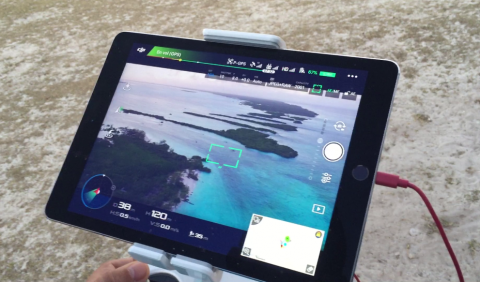
Aldabra is the last remaining place in Seychelles where dugongs can be found, but little is known about the atoll’s elusive dugongs. There is uncertainty about how many dugongs live in the lagoon, what areas of the lagoon they use, whether the atoll is a nursery ground for females to give birth and if they are permanent residents or migrate to Aldabra. The species is listed as vulnerable to extinction by the IUCN and SIF is planning to monitor Aldabra’s dugong population to understand more about them.
Dugong in the lagoon © SIF
The remote and isolated location of Aldabra makes monitoring mobile animals logistically complex. Surveying marine mammals over large water bodies usually includes expensive aerial surveys by crewed aircraft which are dangerous and put personnel lives at risk. In the 21st century a new era of digital conservation is taking place. Remotely piloted aircraft commonly known as ‘drones’ are being used to monitor wildlife. Drones come in a variety of shapes and sizes; equipped with a camera they can capture images and videos from the sky. SIF is currently assessing the feasibility of using drones as a tool to monitor the distribution and number of dugongs living within the shallow lagoon waters of Aldabra.
A drone at the research station © SIF
Information gathered could expand current knowledge of dugongs within the West Indian Ocean and guide conservation measures to protect them. In the region, dugongs likely survive at Aldabra because its status protects them from exploitive human activities, but globally, dugongs are faced with the loss of their primary habitat, seagrass. They are hunted for meat, and are victims of by-catch, pollution, and boat collisions. It is thus vital to understand the impact of strictly protected refuges like Aldabra for the species at a regional level.
There are numerous environmental and biological factors to consider when flying a drone within a strict nature reserve. Despite the many positive potential applications of drones they often carry a negative stigma regarding their use, reaching media headlines for the wrong reasons. However, in addition to drones as a conservation tool, there is rising interest among tourists and film crews to use drones to capture footage of Aldabra’s scenery and biodiversity. To ensure that drone use does not cause any disturbance to wildlife, regulations are currently being drafted that will govern all future drone use on the atoll. These will ensure that drone technology has a positive impact on Aldabra, aiding in conservation and helping to share footage of this beautiful atoll without harming any of its inhabitants.






